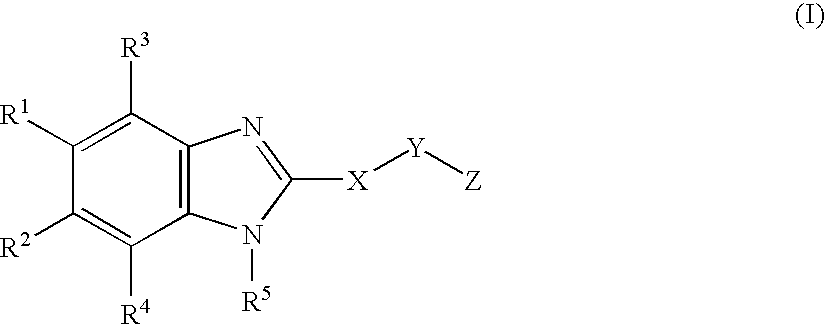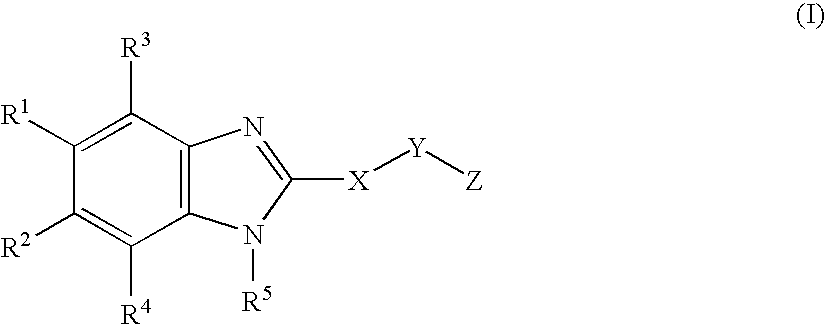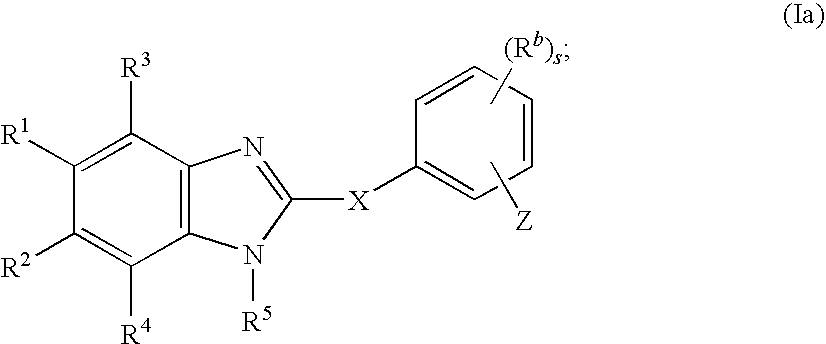Cyclic benzimidazole derivatives useful as anti-diabetic agents
a technology of cyclic benzimidazole and derivatives, which is applied in the direction of biocide, drug composition, metabolic disorder, etc., can solve the problems of insufficient insulin-mediated activation of uptake, oxidation and storage of glucose in muscle, inadequate insulin-mediated repression of lipolysis in adipose tissue, and inability to achieve the effect of reducing the risk of diabetes in patients
- Summary
- Abstract
- Description
- Claims
- Application Information
AI Technical Summary
Benefits of technology
Problems solved by technology
Method used
Image
Examples
example 1
[0510]
5-[(5-biphenyl-4-yl-6-chloro-1H-benzimidazol-2-yl)oxy]-2-methylbenzoic acid
[0511]Step A 5-biphenyl-4-yl-6-chloro-2-(methylsulfonyl)-1H-benzimidazole. To a solution of potassium phosphate, tribasic (2 M solution in water) (63 mL, 126 mmol), Pd(PPh3)4 (2 g, 1.7 mmol), 4-biphenylboronic acid (12.5 g, 63.1 mmol) and Intermediate 1A (15 g, 42.1 mmol) in dioxane (300 mL) was heated at 100° C. for 5 h. The aqueous phase was removed and the organic phase was concentrated, diluted with EtOAc and DCM, filtered and concentrated to afford the desired product as a white solid, which was used in the next step without further purification.
[0512]Step B Methyl 5-[(5-biphenyl-4-yl-6-chloro-1H-benzimidazol-2-yl)oxy]-2-methylbenzoate. A solution of 5-biphenyl-4-yl-6-chloro-2-(methylsulfonyl)-1H-benzimidazole (6.08 g, 36.6 mmol) and Intermediate 5 (7 g, 18.28 mmol) in DCM (100 mL) was concentrated. The resultant solid was placed under nitrogen in a sealed vessel and heated at 130° C. for 3 h, then...
example 66
[0518]
5-{[6-chloro-5-(2-naphthyl)-1H-benzimidazol-2-yl]oxy}-2-methylbenzoic acid
[0519]Step A Methyl 5-{[6-chloro-5-(2-naphthyl)-1H-benzimidazol-2-yl]oxy}-2-methylbenzoate. A microwave vial was charged with Intermediate 12 (95 mg, 0.215 mmol), 2-naphthyleneboronic acid pinacol ester (79 mg, 0.311 mmol), Pd(PPh3)4 (37 mg, 0.032 mmol), DMF (2.1 mL), and 1 M aqueous K2CO3 (0.64 mL). The reaction was heated at 150° C. under microwave irradiation for 8 min. The reaction was partitioned between water and EtOAc. The aqueous phase was extracted with EtOAc. The combined organics were washed with brine, dried (Na2SO4), filtered and concentrated. Chromatography over silica eluting with 30% EtOAc / hexanes afforded the desired product as a yellow-orange oil.
[0520]Step B 5-{[6-chloro-5-(2-naphthyl)-1H-benzimidazol-2-yl]oxy}-2-methylbenzoic acid. To a solution of methyl 5-{[6-chloro-5-(2-naphthyl)-1H-benzimidazol-2-yl]oxy}-2-methylbenzoate in MeOH (3 mL) was added NaOH (2.5 M in water) (0.5 mL, 1 mm...
example 67
[0521]
5({6-chloro-5-[(2-fluorophenyl)ethynyl]-1H-benzimidazol-2-yl}oxy)-2-methylbenzoic acid
[0522]Step A Methyl 5-({6-chloro-5-[(2-fluorophenyl)ethynyl]-1H-benzimidazol-2-yl}oxy)-2-methylbenzoate. A mixture of Intermediate 12 (930 mg, 2.1 mmol), 1-ethynyl-2-fluorobenzene (278 mg, 2.3 mmol), ammonia (3 mL, 21 mmol), cupper (I) iodide (40 mg, 0.2 mmol) and bis(triphenylphosphine)palladium(II) chloride (147 mg, 0.2 mmol) in 10 mL DMF was heated under nitrogen at 140° C. for 1 hour. Volatiles were removed. The residue was redissolved in EtOAc and washed with NaHCO3. Chromatography over silica afforded the desired product as a light yellow solid.
[0523]Step B 5-({6-chloro-5-[(2-fluorophenyl)ethynyl]-1H-benzimidazol-2-yl}oxy)-2-methylbenzoic acid. A solution of methyl 5-({6-chloro-5-[(2-fluorophenyl)-ethynyl]-1H-benzimidazol-2-yl}oxy)-2-methylbenzoate (910 mg, 2.1 mmol) and 4.2 mL 5 M aqueous NaOH in 15 mL MeOH and 15 mL water was heated at 70° C. for 30 min. Volatiles were removed. The re...
PUM
| Property | Measurement | Unit |
|---|---|---|
| pressure | aaaaa | aaaaa |
| pressure | aaaaa | aaaaa |
| pressure | aaaaa | aaaaa |
Abstract
Description
Claims
Application Information
 Login to View More
Login to View More - R&D
- Intellectual Property
- Life Sciences
- Materials
- Tech Scout
- Unparalleled Data Quality
- Higher Quality Content
- 60% Fewer Hallucinations
Browse by: Latest US Patents, China's latest patents, Technical Efficacy Thesaurus, Application Domain, Technology Topic, Popular Technical Reports.
© 2025 PatSnap. All rights reserved.Legal|Privacy policy|Modern Slavery Act Transparency Statement|Sitemap|About US| Contact US: help@patsnap.com



